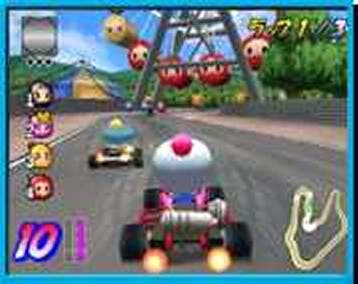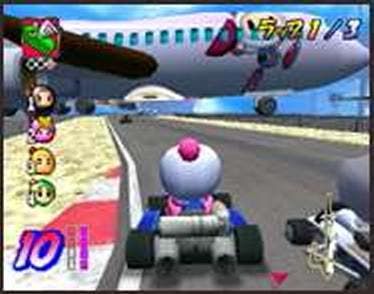Bomberman Kart
Preview - Mugwum goes hands on with Hudson's Japanese mimicry and comes away grinning broadly

Almost Famous
Although the 64-bit version of Mario Kart possessed some of the previous game's spirit, the finest aspects of the game came up short. The tracks were often too wide, long, or overly complex, and the attempts at 3D often lacklustre. The fuzzy N64 graphics were a bit off-putting, and worst of all, Battle Mode - the very foundation of the original's longevity - was spoilt by an insistence on three dimensions, and the absence of Mario Kart's signature claustrophobic track design.
Bomberman meanwhile, managed to achieve even greater things with its unsurprisingly named successor, Super Bomberman 2, but with the advent of the third game things were slipping away. Developer Hudson's problem was that the simple premise and delicate balance of the original games of yore was being skewered by the addition of new power-ups and other gimmicks, which in turn were needed in order to justify further sequels. As such, additions like the ability to return once dead to wreak havoc were somewhat irritating, and many fans stuck with number two. In fact, Super Bomberman 3 never made it further than Japan as far as we remember.
With Nintendo currently working on a GameCube version of their game, Karting matters could be on their way back to form for the Japanese gaming Behemoth, but with that game a long way off it's surprising to find that Hudson and development studio Racjin have together produced a game which is arguably more enjoyable for straight racing than Mario Kart 64, and boasts a fully-fledged Bomberman mode to boot. Reopening the book on the issue of why the PlayStation 2 really does need four controller ports, Bomberman Kart is an unlikely import success.

Rebirth and Fusion
Fun, frollicks and multiplayer nirvana? Definitely, but one thing you won't find in Bomberman Kart is much originality. Right from the introduction you'll have no doubt as to the game's basis. The title screen is laid out almost identically to MK64, and even the twinkling title theme is eerily similar. The graphics are more than just reminiscent of the N64 version of the game with slightly larger character models and karts; the track graphics are ostensibly the same (except with blue and white rumble strips). Even track themes are the same in a lot of areas. Mario circuit is represented, as are the desert, ghost valley, rainbow road, castle and Wild West tracks - right down to the red carpets, rickety railways, wispy clouds of mist and floating spectres.
Trackside animations are nice, with tumbleweed, enchanted furniture, cheering supporters in some areas and even head-bopping Bombersphinxes, and the racers all have a degree of character. You can pick your racer apart from his conveyance, so there's a lot of investigation required to unearth the best combinations, which give you better acceleration uphill, higher top speeds, a smaller turning circle and much more. In time-honoured tradition power-ups litter the track and these include the obvious bombs, which function a lot like MK's bananas, rockets which bounce of the walls (there's ya green shells) and those which home in on a target (and your red ones), as well as boosts - some of which appear on the track if you slip too far off the pace, aww - and other devices.

Inviting
There are all sorts of modes including the ubiquitous grand prix and time trial modes, and with eight tracks initially available and 24 others to unlock there's plenty of variety. The design is visually quite nice even if some of the tracks are a bit spartan, and it's a pity that handsome touches like the railway locomotive and the floating chairs in the halls of the spooky mansion don't interfere with events, but then we haven't unlocked everything yet so there's a glimmer of hope in that department.
One of our favourite things about the game though is the control system. You can handle it like your favourite Karter using the face buttons and directional pad or analogue stick to turn, but the dual analogue control system is a lot more versatile. Using the left stick to turn and the right stick to accelerate and brake, you can guide your kart with a lot more subtlety. Power-ups, power sliding and rear view mirrors are controlled by the shoulder buttons, rendering the face buttons unnecessary. However, the simplicity this system affords you and the surprising depth it offers is probably the only sign of Hudson's old-skool ideology at work, and sadly we're aware that even this has been pilfered from elsewhere.
One of the only other annoyances that I've encountered so far is the game's AI. You need to be good to win races. I'm probably missing a difficulty option somewhere, but the other racers in the game are a bit disappointing. They aren't especially competent drivers, but then they don't need to be as every last one of them boosts off the starting line in a manner I have yet to emulate successfully, putting the player at an immediate disadvantage. They fire power-ups which adds to the drama and you can get caught in their wake which makes it difficult to overtake, but on the whole victory is just a matter of concentrating on your race and not spending time in sand traps and long grass.

Four definitely ain't a crowd
Eschew the single player shenanigans though and you're faced with up to four player split-screen racing and a Mario Kart-alike Battle mode - which is fab thanks to the pilfered power-ups - and as with the single player game the framerate is a tip top 60fps, even if this does introduce a hint of clipping. But racing with three of your mates is only the beginning. The other reason to own this and a multitap is the surprise inclusion of a vanilla Bomberman mode, which in terms of longevity at least makes up the other half of the game.
Bomberman, for the unacquainted, is a game which takes place on one screen, shot from above, with no scrolling or any of that nonsense, and gives you control of a small bloke in an odd curvy bike helmet with a limitless arsenal of bombs. The bombs take about three seconds to explode once laid with the circle button, and you have to manoeuvre your chap out of the path of the explosion using the directional pad. The playing area is split into a number of squares, rather like a chess board, and features a number of obstacles - one per square - from the omnipresent and destructible brick blocks to the indestructible pillars which leave you with a simple maze to traverse.
The idea is to blow up your opposition of up to three other CPU or player-controlled Bombermen. To help you do this, you have to first fight your way through the various clusters of masonry towards your target before strategically placing your bomb, which explodes one square up, down, left and right, environment permitting. You can increase the blast radius by collecting flame power-ups, and other power-ups augment your Bomberman in other ways. A boxing glove lets you pound your way through a number of brick squares, for example, allowing you to escape the path of a ticking bomb if another player has managed to trap you, and a spiky bomb means that the bomb will blow up any brick in its blast radius, not just adjacently. As you can probably tell, it's easy to get into, simple to master and uncompromisingly addictive. This rule set, seemingly somewhere between 16-bit SB and SB2, is just the right balance.
Conclusion
Overall Bomberman Kart is worth importing if you have the facility to run it. And it's also unquestionably worth buying a multitap for. Hudson don't release games in the West, but we've seen in the past a number of publishers pursue their games and deliver the curious antics of the Hudson cutesiverse to universal acclaim. This one is well worth following - if Eidos plans to persist with its Fresh Games label for instance, this could make a sterling addition, particularly at the £25 price point!
There is of course the obvious stab to make at Hudson's credibility in releasing this borrowed brilliance. The Karting aspect is so flagrantly purloined in places from the Super Nintendo's finest racer, as to suggest that the publisher is purely in it for the money these days. It couldn't be that, surely? Either way though, I doubt this will leave my PS2 for weeks, and if it does, there's something wrong with me.

